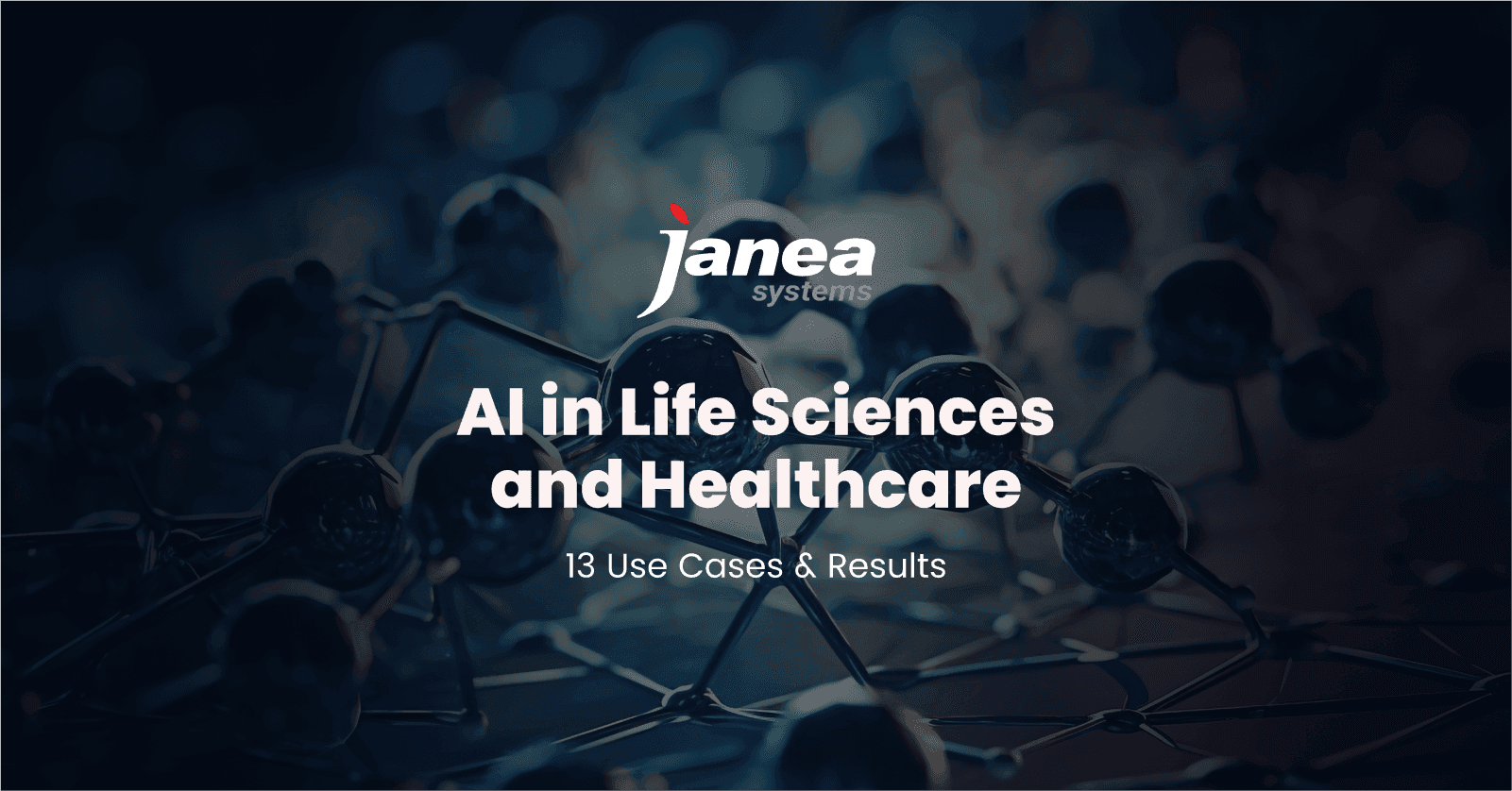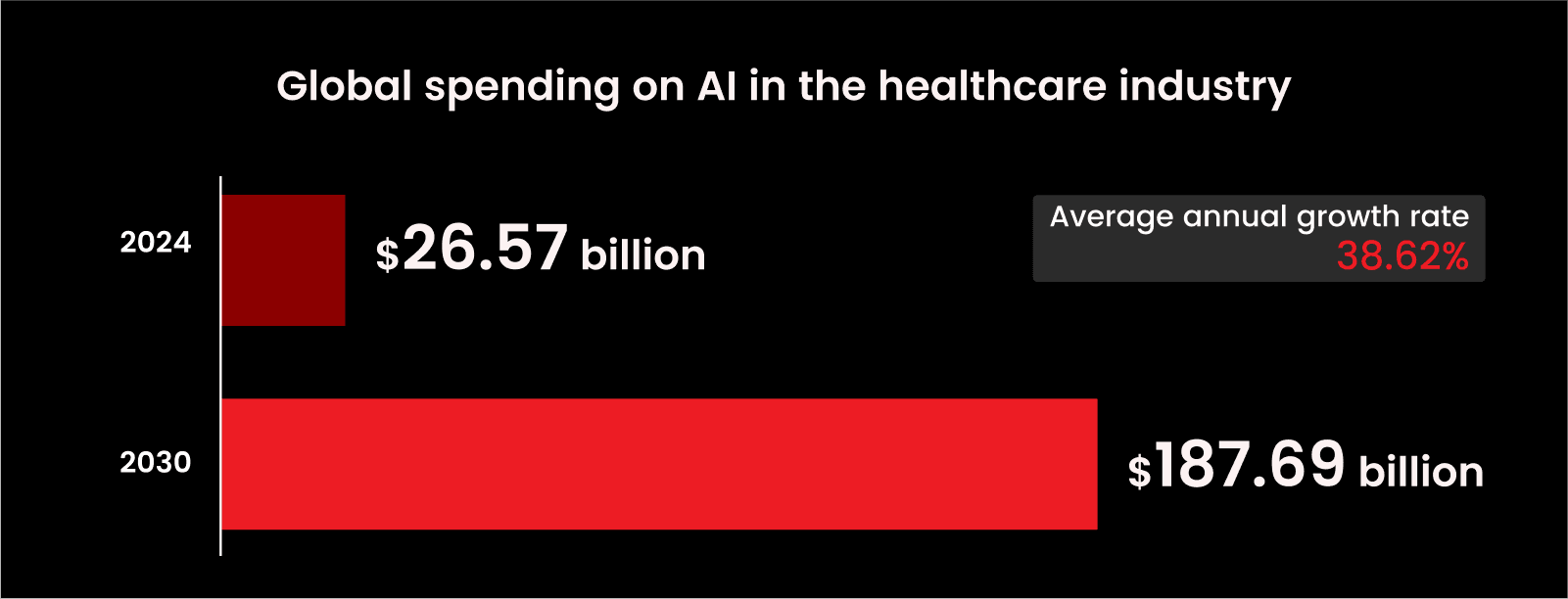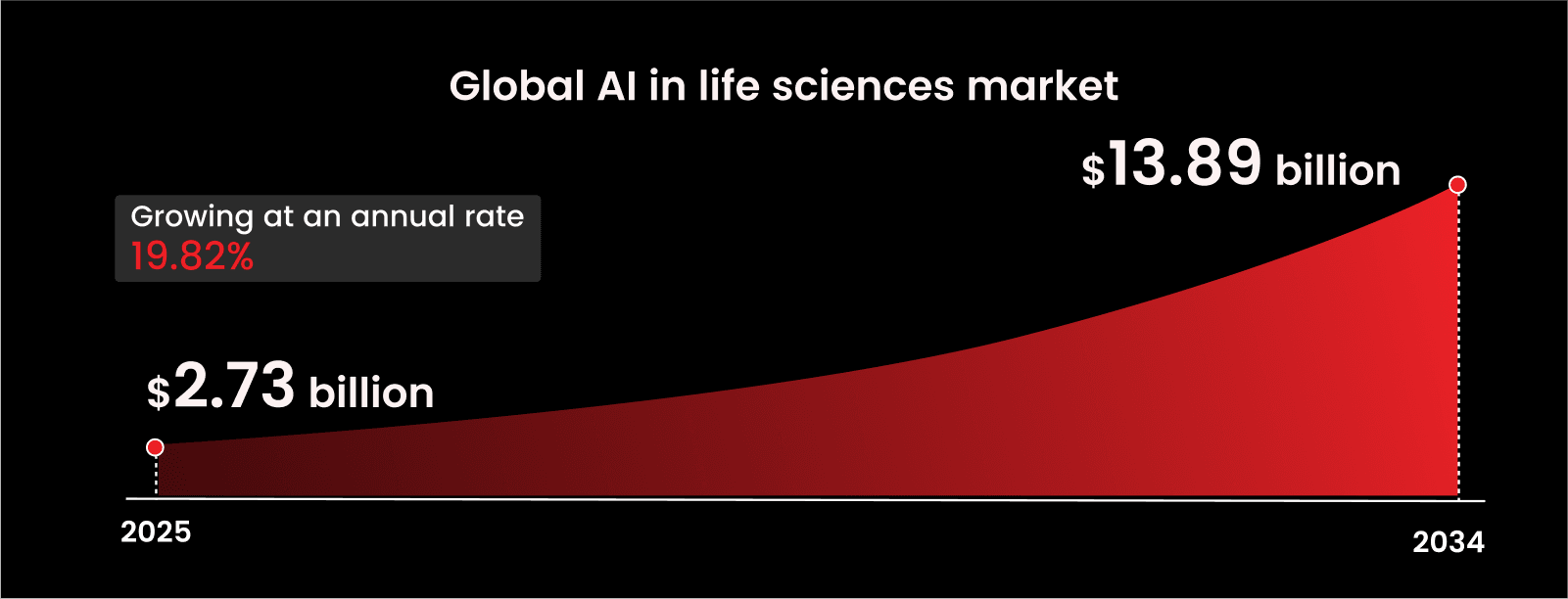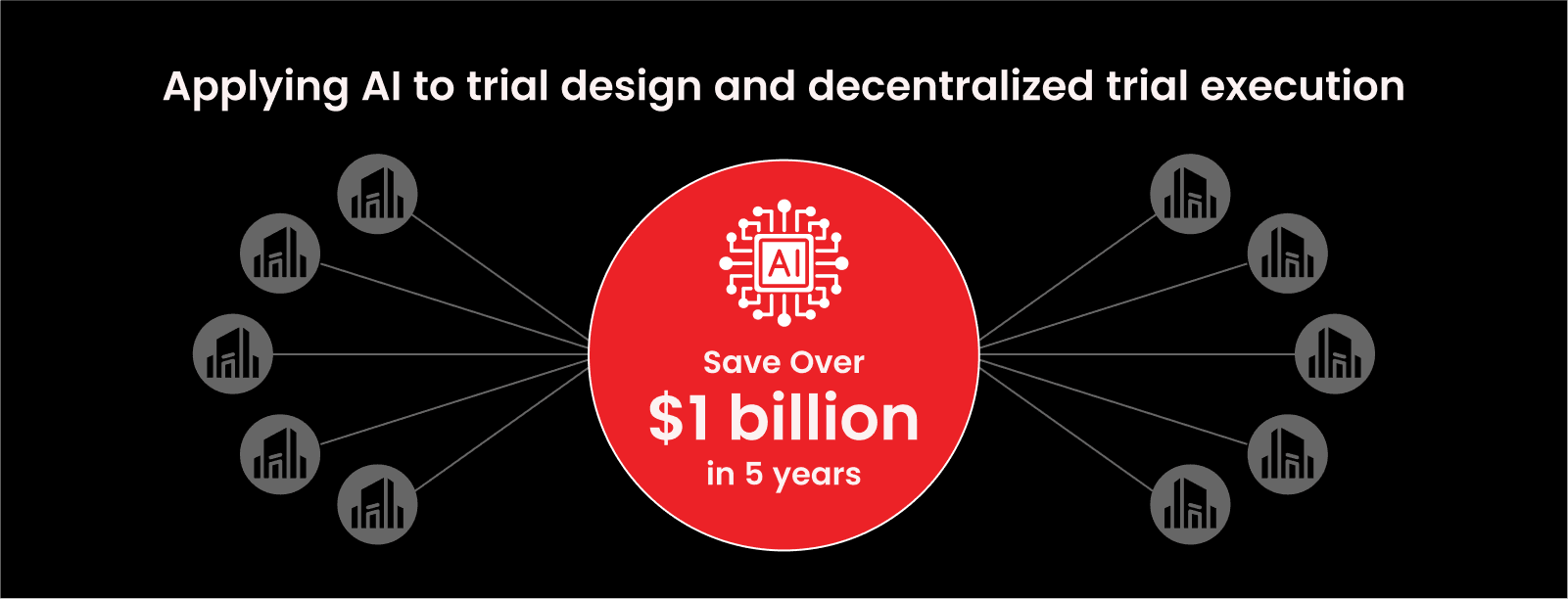AI in Life Sciences and Healthcare: 13 Use Cases & Results
October 15, 2025
By Anastasiia D.
AI Use Cases,
Healthcare,
Life Sciences

Investment in AI across healthcare and life sciences keeps growing, and the reason is simple: the number of use cases is rising fast, and the results are too impressive to ignore.
At Janea Systems, we don’t ignore AI efficiency. That’s why, in this article, we highlight the most striking examples of AI use cases in healthcare and life sciences, examine both AI benefits and pitfalls, and offer recommendations on how to adopt AI with confidence.
AI in Healthcare and Life Sciences Statistics
Before exploring specific areas of AI’s impact on life sciences and healthcare, it’s worth first looking more broadly at where AI stands in these fields today:
Global spending on AI in the healthcare industry reached $26.57 billion in 2024 and is expected to approach $187.69 billion by 2030, representing an average annual growth rate of 38.62%.

Although the numbers are more modest, the global AI in life sciences market still shows healthy growth. It’s valued at $2.73 billion in 2025 and is expected to reach $13.89 billion by 2034, growing at an annual rate of 19.82%.

A World Economic Forum and ZS Associates study found that top-10 pharma companies could save over $1 billion across five years by applying AI to trial design and decentralized trial execution.

AI-focused startups captured 42% of all digital health funding in 2024.
If these figures sound intriguing, keep reading — there’s more to see.
AI in Life Sciences: Use Cases and Results
The presence of AI in life science is no longer experimental but part of the daily workflow. The examples below illustrate how far its influence now reaches.
AI as a Lab Partner in Genetic Research
By helping scientists work faster and more precisely, AI is transforming how genetic research is done:
- At Stanford Medicine, researchers built CRISPR-GPT, an excellent example of generative AI in the life sciences market. A model was trained on 11 years of expert discussions and scientific papers dedicated to CRISPR experiments. It suggests experiment designs and flags potential design errors, cutting design time from years to months. This example ties directly to one of the main points from the AI & Big Data Expo — real value comes from AI designed for particular fields, not broad, general systems.
- Mayo Clinic researchers used machine learning for a genetic test that predicts how people respond to GLP-1 weight-loss drugs. Analyzing 10 appetite-related genes, it generates a personalized “calories-to-satiation” score. In nearly 800 adults with obesity, the test revealed wide differences in eating habits (140 to over 2,000 calories per meal) and matched patients with the drugs most likely to help them.
AI as an Accelerator in Drug Discovery
Bringing a new drug to market traditionally takes a decade or more and can cost billions, and sometimes, projects may fail. Here are some AI use cases in life sciences where it helps cut both time and cost:
Recursion Pharmaceuticals used its proprietary AI platform to move a cancer candidate from concept to human trials in 18 months, less than half the industry average.
Across biotech, similar AI systems are cutting preclinical costs by about 30% by filtering out toxic or ineffective compounds early in development.
AI in Healthcare Examples
While AI is enhancing life sciences, its influence is equally visible in everyday clinical practice. Here are some examples of AI use cases in healthcare.
AI as an Early-Warning System for Emerging Diseases
So, how is AI used in healthcare? One key way is through predictive analytics:
- An ML model by AstraZeneca, another example of AI use cases in healthcare, leverages the UK health data repository, which links data from 500,000 participants. Models trained on this data can point to subtle patterns that may indicate possible development of conditions such as chronic obstructive pulmonary disease, Alzheimer’s, kidney disease, and more.
- Delphi-2M is an example of generative AI in healthcare. This model was trained on anonymized health records from more than 2.3 million patients in the United Kingdom and Denmark. It can forecast an individual’s likelihood of developing over 1,000 diseases and even estimate when those diseases might emerge.
- MIT and Massachusetts General Hospital developed an AI model called Sybil that can predict a person’s risk of developing lung cancer up to six years in advance from a single low-dose CT scan.
- Since 2020, 198 AI cameras across five U.S. health systems have screened over 20,000 patients, detecting 3,400+ cases of retinopathy. With 87% sensitivity and 89% specificity, tools like LumineticsCore help detect issues early and quickly connect patients to eye specialists.
AI as an Efficiency Driver in Hospital Operations
How is AI being used in healthcare when it comes to administrative overload that has long strained healthcare systems? Here are some answers:
- Relatient’s Dash Voice AI, launched in April 2025, now handles 62% of inbound calls for healthcare providers, including over 60% of appointment cancellations and 50% of reschedule requests. The system has cut call times by 68%, improved call-center efficiency by up to 20%, and earned 88% positive patient feedback.
- The tool used by At Chelsea and Westminster NHS Trust in London was even featured in AI in healthcare news. It automates discharge paperwork by pulling diagnoses and test results directly from patient records. The system helps doctors finalize summaries faster, freeing beds sooner.
AI as a Personal Guide in Patient Interaction
How patients engage with their care is the final link in the healthcare chain. AI significantly personalizes these interactions. Here are some more AI applications in healthcare:
AI-based patient-support tools boosted medication adherence by 6.7% to 32.7% in clinical studies (covering ~37,000 patients).
Doctors tested an AI assistant called Mo that chatted with patients online. Over three weeks and 926 cases, patients said the AI made information clearer and their overall experience better than regular chat consultations. About 81% of people chose to communicate with the AI, and doctors judged 95% of its answers as safe and accurate.
In a trial with 70 patients, ChatMyopia, an AI assistant for eye care, helped users understand their condition better and feel more satisfied with their visits than those who received standard leaflets.
Want to explore how AI could improve patient interaction in your organization? Reach out to Janea Systems to develop your AI project roadmap.
Pros and Cons of AI in Healthcare and Life Sciences
AI is delivering real gains. Yet, it also introduces some risks that engineers and clinical leaders should plan for. Below, we provide an overview of both the pros and cons of using AI in healthcare and life sciences.
Advantages of AI Applications in Life Sciences and Healthcare
The figures above clearly show how AI is changing life sciences and healthcare for the better. Let’s sum up how it impacts these fields:
- Faster innovation cycles. Tasks that once required months can now be completed in a matter of weeks. With AI, teams don’t have to spend late nights handling administrative tasks; they can focus on making decisions.
- Sharper precision in decision-making. AI gives specialists a way to see more, not differently, but deeper. It picks up the subtle shifts in patterns that the human eye might miss. Combined with a clinician’s or researcher’s experience, those details become something meaningful.
- Earlier warning signs. Another important change AI brings is better timing. It doesn’t just spot subtle signals, but it can do this well before they become serious issues. This way, teams can act sooner, keeping patients’ conditions under control.
- Lighter operational load. Most people in healthcare didn’t choose this work to spend hours on data entry or scheduling. AI helps by handling these routine tasks, freeing up time and mental energy for tasks where human oversight is indispensable.
Disadvantages of AI in Healthcare and Life Sciences
One of the clearest risks of AI and machine learning in healthcare (as in many other fields) is skill drift. When algorithms take over the most complex or repetitive tasks, specialists may become less confident or precise without regular practice.
A study published in The Lancet Gastroenterology & Hepatology discovered that endoscopists who regularly relied on AI for polyp detection during colonoscopies saw their performance drop by 6% when working without the tool. Their ability to spot adenomas, a critical marker for early cancer detection, decreased from 28.4% to 22.4% after a period of regular AI use. The technology worked as intended; the problem started when people had to work on their own.
This doesn’t mean reducing AI adoption. It means building a culture where questioning AI outputs is a normal practice.
Apart from skill drift, it’s also essential to remember the following risks of AI in healthcare and life sciences, particularly related to technical implementation:
- Hidden bias and uneven outcomes. Because AI relies on the data it’s fed, it can also reproduce the biases in that data. In healthcare, this can mean diagnostic tools or treatment models that don’t perform equally well for all groups. Teams should check model results often and retrain them if accuracy drops for certain patients. With open-source AI frameworks, like PyTorch, you can make the training process faster and respond to AI bias in healthcare more quickly.
- Opaque reasoning. AI can come to conclusions without showing how, since much of its reasoning happens in ways that aren’t visible or easy to follow. Yet, clinicians need to understand why a system recommends something before acting on it.
- Integration issues. One of the paradoxes of AI adoption is that organizations aim for intelligent automation, yet they often lack the solid infrastructure needed to support it. However, healthcare systems rely on a complex combination of legacy software and multiple third-party platforms and, sometimes, hardware in the case of IoT products. When you integrate AI, you need to make sure the core tech stack is compatible so that the entire system acts as a coherent solution. This is how you realize AI’s full potential.
A similar principle applies when you build a product from scratch: you also need to develop a cohesive system where data flows smoothly. Take, for example, the Novoscope, a handheld device for ear infection diagnostics, co-developed by our team and OtoNexus. We built data pipelines to ensure secure and consistent communication with Azure and optimized on-device processing for real-time analysis with edge computing. This, along with other improvements, made the Novoscope stable, efficient, and ready for everyday patient evaluation.
How to Keep AI Useful and Human
Some of the challenges we discussed around using AI in healthcare and life sciences are technological at their core. The good news is that they’re solvable with the following approaches.
Design for Seamless Integration
Whether you’re modernizing an existing solution or building a new product, healthcare technology must often integrate with diverse platforms, like Electronic Health Record (EHR) or Clinical Trial Management Systems (CTMS), and have a seamless data flow between them. Achieving that level of integration is key to effective workflow automation.
It’s exactly the challenge we helped a global biopharmaceutical company solve. The client needed to modernize its R&D environment and integrate an external research platform into its existing cloud infrastructure. Our team migrated a complex system made up of nine microservices to the client’s cloud on AWS. Using Terraform, Kubernetes, and Helm, we automated infrastructure provisioning, deployment, and configuration.
We also set up automated security checks using tools like Black Duck and Coverity for software scanning and static code analysis. Additionally, while integrating the external platform, we made sure that all the data generated through it followed standardized formats. As a result, tasks like data collection, validation, analysis, and reporting, which once required significant manual work, are now largely automated.
Keep Humans in the Loop
As AI becomes involved in decision-making, it shouldn’t replace human judgment. Humans must remain part of the AI decision cycle, reviewing outputs, assessing how well the system addresses the problems in practice, and guiding the system’s learning. This way, you’ll make sure AI doesn’t operate in isolation, which helps prevent unnoticed errors and wasted resources.
Design AI that Can Explain Its Decisions
In healthcare, decisions shouldn’t depend on black-box AI models whose reasoning is hidden from users. Your AI systems should follow the principles of Explainable AI (XAI) — an approach focused on making model decisions transparent and interpretable. This way, your AI will be able to demonstrate how it reached a conclusion: which factors influenced it and why it recommended a particular action.
Build Reliable AI solutions in Healthcare and Life Sciences
Successful AI adoption in healthcare and life sciences requires deep technical expertise, not only in AI development itself, but also in DevOps and MLOps. Our senior engineers bring this expertise to the table. We understand the specifics of AI automation in healthcare and have developed multiple complex, mission-critical systems, like automated research workflows and diagnostic platforms.
Janea Systems partnered with OtoNexus to co-develop the core functionality for their groundbreaking device that uses ultrasound and ML to diagnose middle ear infections. Our team engineered an MLOps pipeline to train and deploy their diagnostic models, which achieved a 90% accuracy rate. This robust and scalable infrastructure became the backbone of their innovative tool, accelerating their journey from clinical trials to commercial launch.
For a leading global biopharma company, we tackled the challenge of fragmented R&D by designing a unified platform to automate complex research workflows. By integrating previously siloed data sources and systems, our solution streamlined collaboration between scientists and significantly accelerated their research and development lifecycle.
If your goal is to make AI not only innovative but also reliable, Janea Systems can help you achieve it. Let’s talk about what you’re building — contact us!
Related Blogs
Let's talk about your project
Let's talk about your project
Ready to discuss your software engineering needs with our team of experts?
